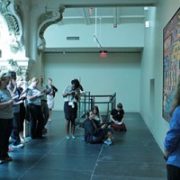Mission Possible: Bridging the Gap
Special thanks to our Smithsonian Affiliations summer intern Lisa Hung (University of California, Irvine) for participating in the Smithsonian’s EdLab Teacher workshops in order to share her experience with us. Here, Lisa reflects on what participating in these workshops meant to her.

Writing 6 word stories that interpret what we see in this piece to spark our creativity, an example of the lively classroom environment EdLab promotes.
She looks up and directs her attention to the front of the room, cringing as she hears the sound of cars zoom across the board with each title. With each chunk of text, she winces at the click of the typewriter flying in from the left of the screen letter by excruciating letter. We’ve all been there; the mess of slides horribly incorporating sounds and effects on a PowerPoint presentation in attempts to bridge the technological gap between students and teachers. Kim Skerritt and Jeff Meade mentioned during the last EdLab workshop, if you don’t feel that the technological aspect of the project will add to the assignment then leave it out.
I was once that girl prefacing each blog I had written for this series, distracted and driven by routine. I’ve been in classrooms where the homework and projects were pulled directly out of the books and listened to lectures in which the material reiterates the textbook verbatim. At the end of the EdLab workshops, we all sought to create our own mission based projects and asked ourselves, as teachers; would we find joy in grading these assignments?Ultimately, what I love about the EdLab workshops is that it does an amazing job integrating our community, interests, and learning while remaining modern. EdLab conducts the workshop in a way that allows for a safe space for the educators to explore and experiment – but it doesn’t end at that, these workshops take the product of our missions and shares them with the public.

At the Smithsonian American Art Museum debriefing after a mission.
21st century technology can be attributed to the idea of mission-based learning in order to create a lively and interactive environment in the classroom. The various Smithsonian museums proved to be wonderful resources that can be utilized in our educational development. As someone who is a visual learner, being up close and personal with the paintings allowed me to better absorb information and apply it to my school and community. I have been able to liberate myself from the stereotypes many people have of Generation Y – and instead, allowed myself to embrace the blessings of this generation and use it to my advantage to create a classroom that aspires towards activism.
Looking for more information about the Smithsonian EdLab program? Click here.





